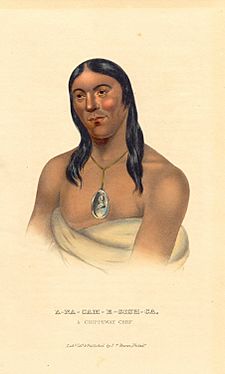Rainy Lake and River Bands of Saulteaux facts for kids
The Rainy Lake and River Bands of Saulteaux (who call themselves Gojijiwininiwag) are a group of Saulteaux people. The Saulteaux are a part of the larger Ojibwe nation. They live in areas of Northwestern Ontario in Canada and northern Minnesota in the United States. Their homes are found along the Rainy Lake and the Rainy River. In the Ojibwe language, this area is known as Gojijiing.
Over time, the Gojijiwininiwag people were divided by new country borders. This happened because of agreements like the Treaty of Paris (1783) and the Webster–Ashburton Treaty in 1842. These treaties set the boundaries between the United States and what was then British North America (which later became Canada). The Gojijiwininiwag living in Canada later became part of Treaty 3.
In Canada, the Rainy Lake and River Bands worked with the government. They dealt with the Department of Indian Affairs, which is now called Aboriginal Affairs and Northern Development Canada. This interaction happened through an office called the Couchiching Agency in Fort Frances. This agency operated from 1871 to 1903. After that, it became known as the Fort Frances Agency. Some Rainy River Bands once shared a special land area called the "Wild Land 15M." The Rainy Lake Bands still share a land area known as the Agency 1.
Contents
Understanding the Names of the Bands
The Rainy Lake and River Bands of Saulteaux get their names from where they live. Rainy Lake is called Gojiji-zaaga'igan in the Ojibwe language. Rainy River is called Gojiji-ziibi. The name of the region, gojijiing, is also used in places like Koochiching County, Minnesota. It is also part of the name for the Couchiching First Nation.
Meet the Rainy Lake and River Bands
The Saulteaux people are organized into different groups called Bands. These Bands often have their own lands, called reserves in Canada. Here are some of the main Bands:
Rainy Lake Bands of Saulteaux
These Bands are located near Rainy Lake:
- Couchiching First Nation: Located in Fort Frances, Ontario.
- Naicatchewenin First Nation: Located near Devlin, Ontario.
- Nigigoonsiminikaaning First Nation: Also in Fort Frances, Ontario. This Band was once known by other names like Nicickousemenecaning First Nation and Red Gut First Nation.
- Stanjikoming First Nation: Located in Fort Frances, Ontario.
Rainy River Bands of Saulteaux
These Bands are located along the Rainy River:
- Lac La Croix First Nation: Found near Fort Frances, Ontario. This First Nation was formed from two older Bands:
- The Lac La Croix Band of Rainy River Saulteaux: They lived on a reserve now called Neguagon Lake Indian Reserve 25D.
- The Sturgeon Lake Band of Rainy River Saulteaux: Their reserve was Sturgeon Lake Indian Reserve 24C. This land became part of Quetico Provincial Park in 1950.
- Little Forks Band of Rainy River Saulteaux [United States]: This group is the southern part of the Little Forks Band. They are now part of the Bois Forte Band of Chippewa near Nett Lake, Koochiching County, Minnesota.
- Rainy River First Nations: Located in Manitou Rapids, Ontario. This First Nation was formed when several smaller Bands joined together. Between 1914 and 1915, six of the seven original Rainy River Saulteaux Bands sold their reserves. They then started to combine into one larger Band. The Canadian government made this official in the 1960s. The seven historical Saulteaux Bands that formed this First Nation are:
- Hungry Hall 1 Band of Rainy River Saulteaux
- Hungry Hall 2 Band of Rainy River Saulteaux
- Little Forks Band of Rainy River Saulteaux [Canada]: This is the northern part of the Little Forks Band.
- Long Sault 1 Band of Rainy River Saulteaux
- Long Sault 2 Band of Rainy River Saulteaux
- Manitou Rapids 1 Band of Rainy River Saulteaux
- Manitou Rapids 2 Band of Rainy River Saulteaux
- Seine River First Nation: Located near Mine Centre, Ontario.


